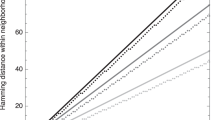Abstract
In this paper, we study the evolution of the mutation rate for simple organisms in dynamic environments. A model based on explicit population dynamics at the gene sequence level, with multiple fitness coding loci tracking a moving fitness peak in a random fitness background, is developed and an analytical expression for the optimal mutation rate is derived. The optimal mutation rate per genome is approximately independent of genome length, something that has been observed in nature. Furthermore, the optimal mutation rate is a function of the absolute, not relative, replication rate of the superior gene sequences. Simulations confirm the theoretical predictions.
Similar content being viewed by others
References
Cox, E. C. (1976). Bacterial mutator genes and the control of spontaneous mutation. Annu. Rev. Genet. 10, 135–156.
Cox, E. C. and T. C. Gibson (1974). Selection for high mutation rates in chemostats. Genetics 77, 169–184.
Chao, L., C. Vargas, B. B. Spear and E. C. Cox (1983). Transposable elements as mutator genes in evolution. Nature 303, 633–635.
Drake, J. W., B. Charlesworth, D. Charlesworth and J. F. Crow (1998). Rates of spontaneous mutation. Genetics 148, 1667–1686.
Eigen, M. and P. Schuster (1977). The hypercycle. A principle of natural self-organization. Part A: emergence of the hypercycle. Naturwissenschaften 64, 541–565.
Gillespie, J. H. (1981). Mutation modification in a random environment. Evolution 35, 468–476.
Gillespie, J. H. (1991). The Causes of Molecular Evolution, Oxford, UK: Oxford University Press.
Ishii, K., H. Matsuda, Y. Iwasa and A. Saskai (1989). Evolutionarily stable mutation rate in a periodically changing environment. Genetics 121, 163–174.
Johnson, T. (1999). The approach to mutation-selection balance in an infinite asexual population, and the evolution of mutation rates. Proc. R. Soc. Lond. B 266, 2389–2397.
Kimura, M. (1967). On the evolutionary adjustment of spontaneous mutation rates. Genet. Res. 9, 23–24.
Kondrashov, A. S. (1995). Modifiers of mutation-selection balance: general-approach and the evolution of mutation-rates. Genet. Res. 66, 53–69.
Leigh, E. G. (1970). Natural selection and mutability. Am. Nat. 104, 301–305.
Leigh, E. G. (1973). The evolution of mutation rates. Genetics 73(Suppl.), 1–18.
McVean, G. T. and L. D. Hurst (1997). Evidence for a selectively favourable reduction in the mutation rate of the X chromosome. Nature 386, 388–392.
Moxon, E. R., P. B. Rainey, M. A. Nowak and R. E. Lenski (1994). Adaptive evolution of highly mutable loci in pathogenic bacteria. Curr. Biol. 4, 24–33.
Moxon, E. R. and D. S. Thaler (1997). The tinkerer’s evolving toolbox. Nature 387, 659–662.
Nilsson, M. and N. Snoad (2000). Error thresholds on dynamic fitness landscapes. Phys. Rev. Lett. 84, 191–194.
Radman, M. (1999). Enzymes of evolutionary change. Nature 401, 866–869.
Smith, J. M. and E. Szathmáry (1995). The Major Transitions in Evolution, Oxford: W. H. Freeman.
Sniegowski, P. D., P. J. Gerrish and R. E. Lenski (1997). Evolution of high mutation rates in experimental populations of E. coli. Nature 387, 703–705.
Sniegowski, P., P. J. Gerrish, T. Johnson and A. Shaver (2000). The evolution of mutation rates: separating causes from consequences. Bioessays 22, 1057–1066.
Author information
Authors and Affiliations
Rights and permissions
About this article
Cite this article
Nilsson, M., Snoad, N. Optimal mutation rates in dynamic environments. Bull. Math. Biol. 64, 1033–1043 (2002). https://doi.org/10.1006/bulm.2002.0314
Received:
Accepted:
Issue Date:
DOI: https://doi.org/10.1006/bulm.2002.0314




